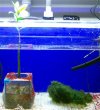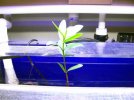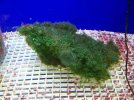prow
Well-Known Member
i had to open my big mouth didn't i. ok like most things in the hobby only part of a cycle is known. in photosynthesis there are two parts, the first part is photosystems and the second is the Calvin Cycle(carbon fixation). other cycles get involved. here i am refering to the Calvin cycle, the second part of photosynthesis(sugars/starches) and photoinhibition(reduction of photosynthetic rates) and the xanthophyll cycle(uses Cadmium inhibits epoxidation of diatoxanthin/ its a regulatory mechanism involved in stress response).
nycthemeral cycles even come into play but, with out getting too into it, because then i would have to go into bio/orgainic chem, with all the eletrons added in to mess.
so in short during the day H20 and startchs are taken in and stored, O2 is produced from these proccesses. at night CO2 is taken up(the carbon source) and the starch is turned to sugar(energy) and used in the tissues for growth. this does occur during photoperiods but with a dark period, faster growth rates result. basically plants store energy during photoperiods and use it for growth at night. the xanthophyll cycle is a compensating mech used to slow photoinhibition during times of stress ie,..high levels of UV radiation and/or PAR levels. compesating mech get used up. perhaps why you hear about people having issues with sudden stoppings of growths or shrinking and disolving issue with cheato after long periods of time. with a dark cycle photosynthesis is more efficient and no unused starches and sugars are released. as a little bonus this is were phosphate bonds are broken to make matters even better there are three stages in the calvin cycle.
to make matters even better there are three stages in the calvin cycle.
a diagram or two.


here are a couple links to what i am talking about. the calvin cycle also adds other organic product aside from sugar. way to tired to go all into this but here are a few link to check out.
Photosynthetic Dark Reaction
Chemistry for Biologists: Photosynthesis
nycthemeral cycles even come into play but, with out getting too into it, because then i would have to go into bio/orgainic chem, with all the eletrons added in to mess.
so in short during the day H20 and startchs are taken in and stored, O2 is produced from these proccesses. at night CO2 is taken up(the carbon source) and the starch is turned to sugar(energy) and used in the tissues for growth. this does occur during photoperiods but with a dark period, faster growth rates result. basically plants store energy during photoperiods and use it for growth at night. the xanthophyll cycle is a compensating mech used to slow photoinhibition during times of stress ie,..high levels of UV radiation and/or PAR levels. compesating mech get used up. perhaps why you hear about people having issues with sudden stoppings of growths or shrinking and disolving issue with cheato after long periods of time. with a dark cycle photosynthesis is more efficient and no unused starches and sugars are released. as a little bonus this is were phosphate bonds are broken
a diagram or two.


here are a couple links to what i am talking about. the calvin cycle also adds other organic product aside from sugar. way to tired to go all into this but here are a few link to check out.
Photosynthetic Dark Reaction
Chemistry for Biologists: Photosynthesis





